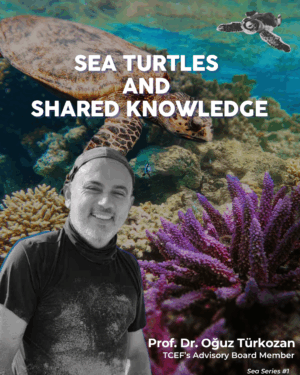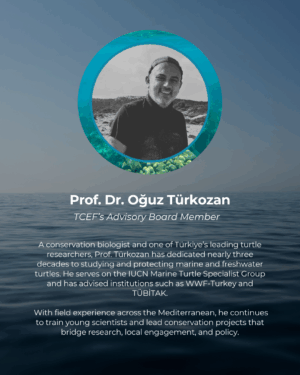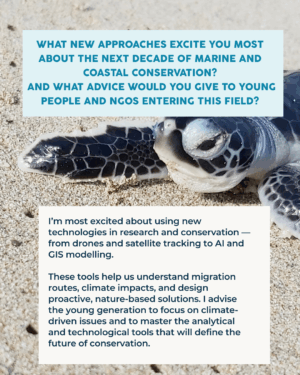TCEF Sea Interview Series: Sea Turtles and Shared Knowledge
Introducing the TCEF Sea Interview Series
Through this new series, we bring together the voices of scientists, conservationists, and creative practitioners from our Advisory Board — sharing their insights, experiences, and visions for protecting Türkiye’s coasts and seas.
In our first conversation, we meet Prof. Dr. Oğuz Türkozan, one of Türkiye’s leading turtle researchers, whose decades-long work bridges science, field experience, and community engagement.


Türkiye’s Mediterranean coasts host some of the most important nesting beaches for sea turtles.How has this richness shaped conservation efforts — and what gives you hope today?
Biodiversity can be defined at different levels — species, ecosystems, and genetics — yet it is often perceived in society simply as the number of species in a given area.
The Mediterranean is one of the world’s richest biodiversity hotspots, both on land and at sea. Unfortunately, it is also one of the most vulnerable regions to the climate crisis.
Since joining Türkiye’s first sea turtle conservation efforts as a first-year biology student in 1988, I have witnessed remarkable progress — from small, volunteer-driven initiatives to systematic, science-based conservation.
Over the years, public awareness and civil society’s involvement have grown significantly, strengthening biodiversity monitoring and protection. Citizen science, in particular, has helped identify previously unknown or underestimated biodiversity areas.
What gives me hope today is seeing that much of society now understands the importance of biodiversity — questioning harmful actions on scientific grounds, and designing stronger, higher-quality conservation projects with this awareness.
How do volunteers, scientists, and institutions shape sea turtle conservation in Türkiye? And what needs to be strengthened for lasting impact?
Each group plays a vital but distinct role in sea turtle conservation.
Volunteers form the cornerstone of these efforts. People from diverse backgrounds and educational levels come together around a shared purpose, gaining both personal and collective experiences in the process. They learn how to collect and analyze data, and their time in the field — the conversations, collaborations, and shared efforts — deepens their understanding of conservation. Volunteers are not only physically present on nesting beaches but also play a key role in spreading environmental awareness through social media and community engagement.
Academia identifies problems, designs projects, determines which data need to be collected, and transforms findings into scientific reports and publications. It also carries the responsibility of training volunteers and future scientists.
Civil society organizations play a critical role in communicating research results to the public, supporting implementation, and ensuring follow-up. The legal dimension of protection — enforcement and regulation — falls to government institutions.
Sea turtles have long been flagship species in Türkiye, driving awareness and inspiring conservation initiatives. The collective effort of volunteers, academia, and institutions has contributed to a significant success: the IUCN status of the green turtle (Chelonia mydas) has improved from “Endangered” to “Least Concern.”
To sustain this progress, data collection must continue and enforcement mechanisms must be strengthened.
The IUCN recently improved the green sea turtle’s conservation status from “Endangered” to “Least Concern. How do you interpret this progress, and what lessons can we take from it in Türkiye?
Türkiye hosts the most important nesting beaches for green sea turtles in the Mediterranean — critical for the survival of the species’ regional population.
For over 35 years, research and protection efforts have been carried out on these nesting beaches with the support of government institutions and civil society organizations.
This long-term commitment has played a major role in the IUCN’s positive reassessment.
However, it is not sufficient on its own. Sea turtles use different habitats throughout their lives. While they lay their eggs on Türkiye’s beaches, they spend their feeding and overwintering periods along the coasts of North Africa — especially near Tunisia and Libya.
If those countries had not also implemented conservation measures, the success achieved in Türkiye alone would have had a limited effect.
This underlines the importance of international cooperation in marine conservation. The progress we see today is the result of decades of collaboration across borders.
The hatchlings that were once protected under wire cages have now reached sexual maturity — returning to the same beaches to nest.
From Türkiye’s perspective, three lessons stand out:
- The importance of continuous data collection,
- The need for transparent communication of results to the public,
- The value of strong international collaboration.
Building collaboration between academia, government, and civil society is increasingly vital for marine conservation. How can we strengthen a culture of learning and sharing between these sectors?
To strengthen a culture of collaboration and shared learning, I believe we need more workshops and meetings that bring together scientists, NGOs, and institutions working in this field. Regular opportunities to connect and exchange ideas help build understanding and trust among partners.
Additionally, online platforms — such as dedicated websites or mailing lists — can facilitate the timely sharing of information and create networks that accelerate cooperation.


This interview is part of TCEF’s “Sea Series,” a collection of conversations with members of TCEF’s Advisory Board. The series highlights experts working across Türkiye’s marine and coastal ecosystems — sharing their experiences and connecting science, art, and community-based conservation.
